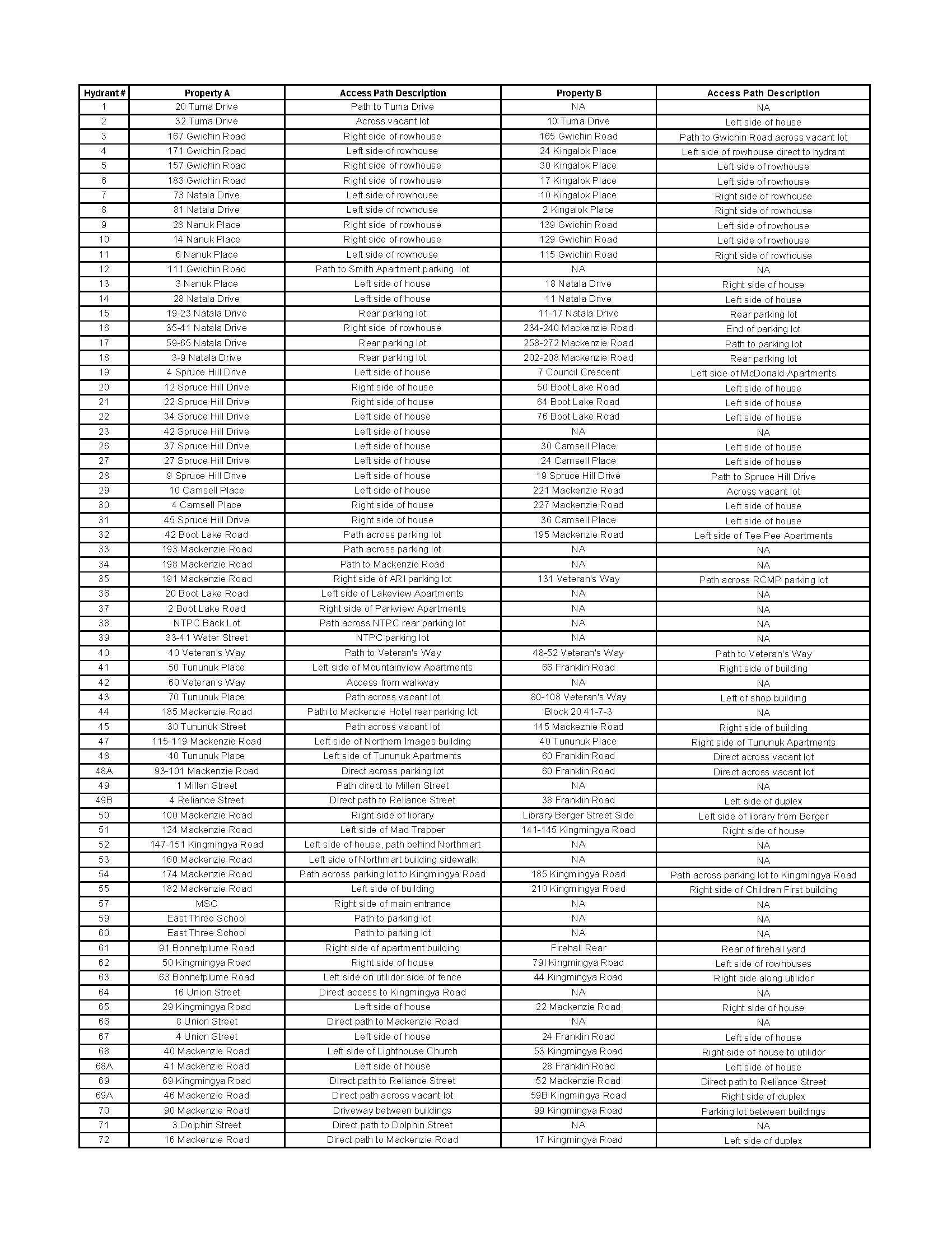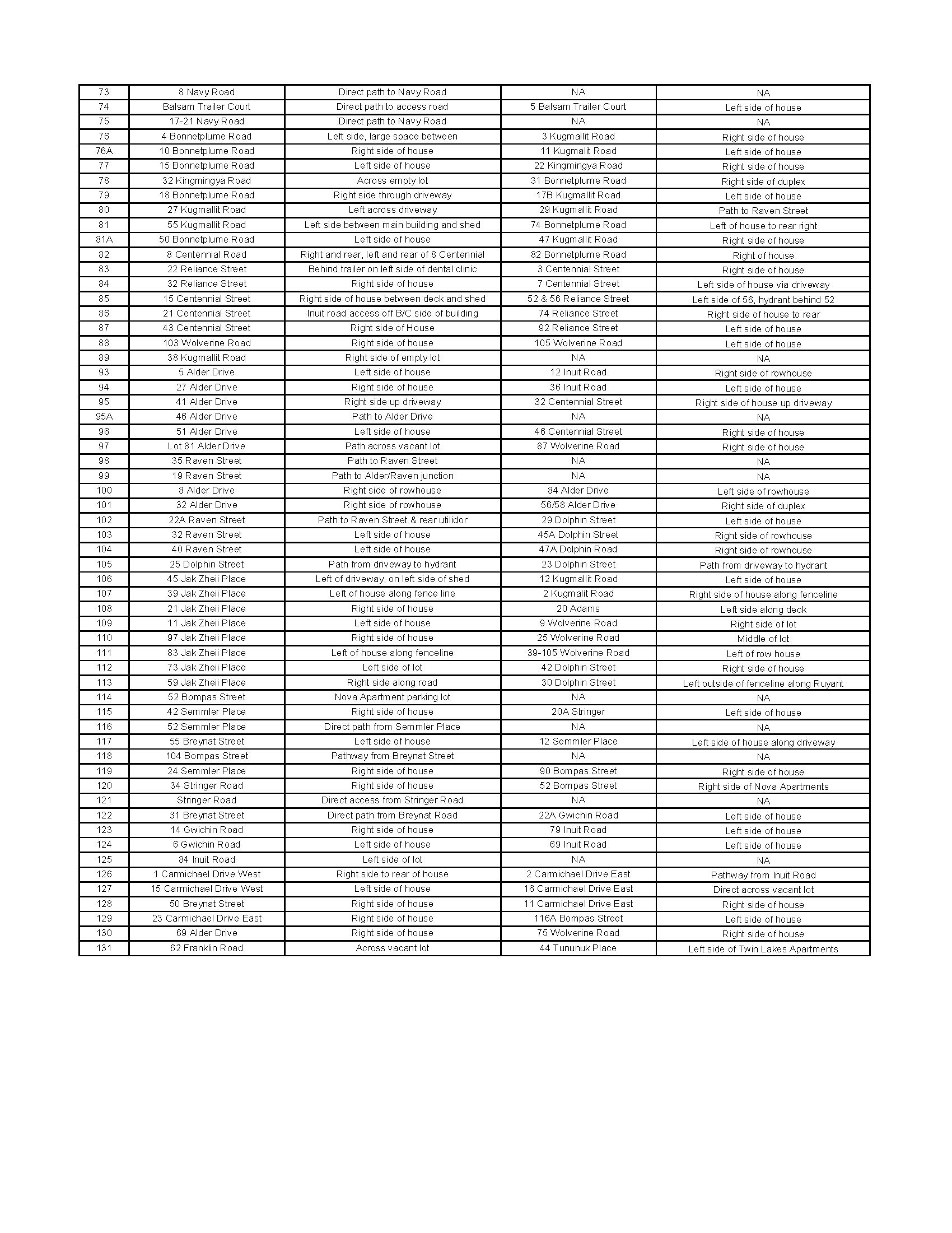FAQ's
|
What law requires maintaining access routes and hydrant clearances? |
| Town of Inuvik By-laws 2691/FC/22 Fire Hydrant By-law and 2657/UTIL/20 Water and Sewer Administration, Management and Operations By-law outline the specific requirements. The specific sections in By-law 2657 are: S. 3.9-3.11; S. 13.5-13.8; S. 15; S. 19. |
|
I do not agree with the access route: what can I do? |
|
If you don’t agree with the route through your property or don’t agree that you are legally responsible for maintaining the route, please contact us at IFD@inuvik.ca or (867)777-8616 to discuss. Routes are chosen based on in-person observations, choosing a path that balances operational requirements and realistic maintenance activities. Examples of scenarios that could redraw the path: I would prefer the route follows a driveway or footpath as I typically keep this clear; firefighters may encounter difficulties with a route due to a stream, creek, or other unobserved natural obstruction; the route indicated is not the correct property (ie address incorrect). Examples of scenarios that would not redraw the path: I store my boat there and I would prefer a different hydrant be used; I have built a fence and do not want to relocate or install a gated access; the hydrant can be accessed from the other side of the utilidor. |
|
Have property owners always been responsible for maintaining paths? |
| The various enabling By-laws have been in effect since the establishment of our fire hydrant system. The previous identification list only noted a single address based on the direction the hydrant is facing: our system relies on providing 360° coverage based on a specified radius from each hydrant. Section 3.10 of By-law #2657 allows the Fire Chief to determine locations of access paths; these paths may be altered from time to time based on operational requirements, observations, and changes in development. A record of current access paths is posted on this page and can be obtained by request at any time. |
|
Why is it important to maintain access paths & working clearances around hydrants? |
|
Inuvik is fortunate to have a hydrant system that can aid in fire suppression efforts: the unique nature of our system requires community cooperation and adherence to these requirements. The IFD trains for “worst case scenarios”, which include obstructed and difficult to access paths, but time is of the essence in an emergency scenario. Reducing obstructions and maintaining clear access results in faster water on the fire and safer neighbourhoods. Fires affect and damage neighbouring homes and buildings: you are helping your neighbours, families, and friends by complying with the By-law! |
|
I am exempt from paying property taxes: do I need to maintain access and clearances? |
| No, if you are exempt from paying property taxes the Town will clear the access paths and maintain clearances. The access path list is cross-referenced with the exemption list and provided to the TOI Public Works Department. |
|
I am a tenant: am I responsible for maintaining access paths and working clearances? |
|
Maybe. It depends on your tenancy agreement: discuss this with your landlord to determine if it is a lease requirement to shovel snow and provide clearances. Inuvik Housing Authority tenants are not required to clear paths; arrangements have been made with Housing NWT and IHA to ensure routes are cleared on IHA properties. You may be required to move items by IHA if they are blocking access. Ultimately, property owners are responsible for maintenance and access, even if the tenant is required to do so under the lease agreement. |
|
What area do I need to clear? |
|
We require a 3m space in any given direction, including above and below a hydrant. Where possible, clearance should be provided underneath the utilidor as well; supply hose is best run underneath as opposed to overtop of a utilidor. Access paths should be shoveled and clear of obstructions including vegetation. Adequate lighting is welcomed but not required. The access path list makes general references, ie “right side of house” or “rear parking lot”: these are for reference purposes and the access path must extend from the road to the hydrant following these descriptions. If in doubt, please contact the IFD for clarification! All path descriptions (left/right side) are based on facing the property from the road. |
|
What happens if I do not clear access routes? |
|
The IFD and MED will be conducting regular inspections of access routes and clearances during patrols, training events, and as requested or noted. We strive to provide education and solutions while ensuring that our community is safe. An initial verbal request will be followed by a written order if the situation is not resolved in a timely manner. If the written order is ignored, the Town may choose to clear the obstruction and invoice the property owner for any applicable costs and administrative fees. Non-compliance may also result in fines in accordance with the above referenced By-laws. When IFD personnel encounter obstructions such as fences, sheds, or other items impeding access to fire hydrants during emergency responses, they will remove the obstruction using the tools available to them at that moment. |
PDF Download : Fire Hydrant Access Route











